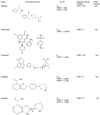Perspectives on PARP inhibitors as pharmacotherapeutic strategies for breast cancer
- PMID: 33646064
- PMCID: PMC9047307
- DOI: 10.1080/14656566.2021.1876662
Perspectives on PARP inhibitors as pharmacotherapeutic strategies for breast cancer
Abstract
Introduction Approximately 10% of all breast cancer cases occur in individuals who have germline pathogenic variants of the BRCA 1, BRCA 2, and other genes associated with impaired DNA damage repair that is associated with an increased risk of breast, ovarian, and other cancers. Inhibitors of poly-ADP ribose polymerase (PARP) induce synthetic lethality in cancer cells harboring such pathogenic variants.Area covered In this review, the authors review the mechanisms of action, antitumor activity, and adverse events associated with PARP inhibitors for the treatment of advanced breast cancer. The authors then summarize the area and provide their expert perspectives on the area.Expert opinion Two PARP inhibitors are approved in metastatic breast cancer, including olaparib and talozaparib. Both agents were approved based on phase III trials demonstrating that they were associated with improved progression-free survival compared with treatment of physician's choice in patients receiving second-third line therapy for locally advanced, inoperable, or metastatic breast cancer in patients with germline pathogenic BRCA 1 or BRCA2 variants.
Keywords: BRCA 1 or 2 mutation; DNA repair defect; PARP inhibitor; breast cancer.
Conflict of interest statement
Reviewer Disclosures:
Peer reviewers on this manuscript have no relevant financial or other relationships to disclose.
Figures



Similar articles
-
Advances in PARP inhibitors for the treatment of breast cancer.Expert Opin Pharmacother. 2015;16(18):2751-8. doi: 10.1517/14656566.2015.1100168. Epub 2015 Oct 20. Expert Opin Pharmacother. 2015. PMID: 26485111 Review.
-
[From poly(ADP-ribose) discovery to PARP inhibitors in cancer therapy].Bull Cancer. 2015 Oct;102(10):863-73. doi: 10.1016/j.bulcan.2015.07.012. Epub 2015 Sep 15. Bull Cancer. 2015. PMID: 26384693 Review. French.
-
Resurrection of PARP Inhibitors in Breast Cancer.J Natl Compr Canc Netw. 2018 Sep;16(9):1150-1156. doi: 10.6004/jnccn.2018.7031. J Natl Compr Canc Netw. 2018. PMID: 30181424 Review.
-
PARP inhibitors in breast cancer: Bringing synthetic lethality to the bedside.Cancer. 2018 Jun 15;124(12):2498-2506. doi: 10.1002/cncr.31307. Epub 2018 Apr 16. Cancer. 2018. PMID: 29660759 Free PMC article. Review.
-
PARP (Poly ADP-Ribose Polymerase) inhibitors for locally advanced or metastatic breast cancer.Cochrane Database Syst Rev. 2021 Apr 22;4(4):CD011395. doi: 10.1002/14651858.CD011395.pub2. Cochrane Database Syst Rev. 2021. PMID: 33886122 Free PMC article.
Cited by
-
Design and Activity of Novel Oxadiazole Based Compounds That Target Poly(ADP-ribose) Polymerase.Molecules. 2022 Jan 21;27(3):703. doi: 10.3390/molecules27030703. Molecules. 2022. PMID: 35163965 Free PMC article.
-
PARP Inhibitors Display Differential Efficacy in Models of BRCA Mutant High-Grade Serous Ovarian Cancer.Int J Mol Sci. 2021 Aug 7;22(16):8506. doi: 10.3390/ijms22168506. Int J Mol Sci. 2021. PMID: 34445211 Free PMC article.
References
-
- O’Connor MJ. Targeting the DNA Damage Response in Cancer. Mol Cell. 2015;60(4):547–560. - PubMed
-
- Schreiber V, Dantzer F, Ame JC, de Murcia G. Poly(ADP-ribose): novel functions for an old molecule. Nat Rev Mol Cell Biol. 2006;7(7):517–528. - PubMed
-
- Hassa PO, Hottiger MO. The diverse biological roles of mammalian PARPS, a small but powerful family of poly-ADP-ribose polymerases. Front Biosci. 2008;13:3046–3082. - PubMed
Publication types
MeSH terms
Substances
Grants and funding
LinkOut - more resources
Full Text Sources
Other Literature Sources
Medical
Miscellaneous
